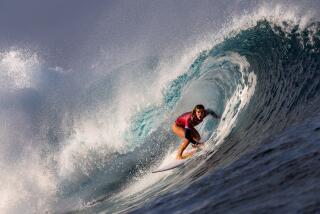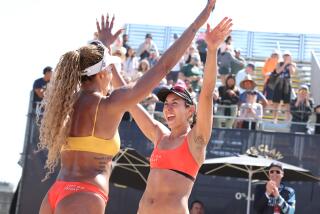When He Judges, Dana Pointâs Wieser...
SAN CLEMENTE â Kelly Slater managed to get his surfboard completely out of the water and landed without falling off. Noah Budroe defied gravity, aiming his board straight up the face of the wave before spinning it around in a slashing turn. And Chris Brown slid across the top of a breaking section of wave before weightlessly dropping down with the tumbling curl.
All three spectacular maneuvers elicited oohs of admiration from the crowd at the San Clemente Pier. But only a handful of people on the beach had to apply numerical values to the moves in order to determine the winner of this talent-laden heat during the recent Body Glove San Clemente surf meet.
One of them, Carl Wieser of Dana Point, a veteran judge of the Professional Surfing Assn. of America tour and the ASP world tour, admits it isnât always easy.
âThe key thing is where the maneuver is executed,â he said. âYou want to put your moves right into the hook of the curl, the most critical section. And since most maneuvers are really three moves in one, maintaining speed throughout the maneuver is essential.
âThe three-biggest moves in surfing are the snap (turn) right in the hook, the roundhouse (180-or-more degree) cutback and the floater. What weâre looking for is the big, explosive move. Itâs not so much the maneuver as how critical it was, how difficult it was to pull off.â
This week, the best surfers in the world have congregated at Huntington Beach for the Op Pro, so impossible aerials, incredible re-entries and gravity-defying, gouging turns will be the order of the day. Wieser and the others on the panel of ASP judges will be left to decide whatâs best on the menu. ASP heats are one-on-one competitions, so the judges can hope that one surfer catches all the good waves and is a clear winner.
Judging surf contests is an enviable and yet difficult job that requires more than a good sunscreen. Thick skin helps, too.
All scorecards are available for the surfersâ scrutiny and, therefore, judges might get some unfriendly stares from competitors who believe theyâve been slighted. Debates between judges and surfers are common, but most of the conversations stay on a civil level.
These surfers ride waves for a living and there is a considerable amount of money to be won every time a competitor paddles out. Surfers have lived their entire lives marveling at how fickle the ocean can be, and theyâre resigned to the fact that being in the right spot at the right time and slipping into the best wave of a heat can be more important than talent. No one in this sport will argue that itâs often better to be lucky than good.
So surfers realize they donât compete under equal conditions and that strategy, the patience to wait for a good wave and the skill to judge which wave will be best, are as important as raw talent.
But the judging is subjective and that sometimes causes tension between surfers and judges. While length of a ride is important--the longer the wave, the more chances to execute scoring maneuvers--you canât put a tape measure on a cutback and there are no speedometers on the boards. Speed and power are critical, but some surfers just look faster and stronger.
And then thereâs the nebulous matter of style.
The ASP rule book describes style as riding waves in âa manner which expresses personal style and fluidity . . . the more electric the style, the better the score.â
OK, who brought the volt meter?
âSure, thereâs a great deal of subjectiveness involved,â Wieser said. âThere are going to be styles of surfing that you, as a judge, prefer over others. Some surfers just seem awkward to you and thatâs when (judging) experience comes in.
âWhen youâre inexperienced, you tend to just look at style. But when you judge the same guys over and over for a few years, you learn how to watch where the guyâs board is, where itâs positioned on the wave, and concentrate on his control.â
The top four waves of a 10-wave maximum were scored in the preliminary rounds at the Op Pro, with the top five of 15 counting in the finals. Each ride is rated by each judge on a scale of 1 to 10 (but since judges can add a figure after the decimal point, itâs really the same as a 1-to-100 scale).
The scores of the high and low judges on the five-man panel are discarded and the totals are added to produce a score. So, there are 30 points possible on each ride and 150 points would be a perfect score in a final. (The highest score in a final last year on the ASP tour was 123.5, scored by world champion Martin Potter).
âOn this level, there are so many good surfers that there are a lot of really close heats,â Wieser said. âThese guys are out there matching move for move, series of exchanges for series of exchanges. I think the most important thing a judge can do is make absolutely sure that there is a real difference on your card between a real good ride and an average good ride.â
Wieser says the Op Pro is a difficult test for judges because the waves at Huntington Beach Pier pass over a deep spot where they diminish in size and then reform into a fast-breaking shore break. The âHuntington Hopâ--where the surfer jumps up and down on his board to stay with the wave until it reforms--was born of necessity since length of ride is one of the judging criteria.
âYou have to keep in mind what sorts of maneuvers the surfer performed on the original wave at the beginning of the ride, though,â Wieser said. âIf he makes all his moves inside on the reform, than thatâs a poor ride.â
As is the case with most judges, Wieser was originally a competitive surfer. While competing as an amateur on the National Scholastic Surfing Assn. tour, he began judging some events to pick up spending money. He got his big break when he was asked to judge the 1985 Op Pro.
âI was trying to decide whether to turn pro or keep judging, and judging seemed like it was going to provide a much more stable income,â he said.
This is Wieserâs third full year on the ASP tour, which means he spends a lot of time in hotels and a lot of time riding the waves off exotic beaches. So far this year, the ASP has made stops in South Africa, Australia and Hawaii, with more contests set to come in Europe, Brazil, Japan and the South Pacific.
âI went to South Africa three weeks early to have a look around and go surfing,â he said. âI do that whenever I get the chance.
âAs a judge, you spend some long days at the beach and there are times youâd much rather be in the water than watching other guys surf, but all in all, itâs a pretty good way to make a living.â
As the sport has blossomed, more and more surfers are coming to that conclusion. And the competition for a seat in the judgesâ booth up on the scaffolding may soon be almost as fierce as it is for the best waves.
âWhen I started judging, there really wasnât that many people doing it,â Wieser said. âNow, every event I go to there are people asking me how they can become an ASP judge.â
More to Read
Go beyond the scoreboard
Get the latest on L.A.'s teams in the daily Sports Report newsletter.
You may occasionally receive promotional content from the Los Angeles Times.










